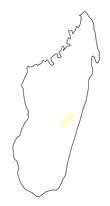Golden mantella
| Golden mantella | |
|---|---|
| | |
| Yellow/Golden form | |
| | |
| Red form | |
| Scientific classification | |
| Kingdom: | Animalia |
| Phylum: | Chordata |
| Class: | Lissamphibia |
| Order: | Anura |
| Suborder: | Neobatrachia |
| Family: | Mantellidae |
| Subfamily: | Mantellinae |
| Genus: | Mantella |
| Species: | M. aurantiaca |
| Binomial name | |
| Mantella aurantiaca (Mocquard, 1900) | |
 | |
| Distribution of the golden mantella in Madagascar | |
The golden mantella (Mantella aurantiaca) is a small, terrestrial frog endemic to Madagascar. It has an extremely restricted distribution in three distinct areas centered on the town of Moramanga - Beparasy and Ambohibary Communes, Torotorofotsy Wetland northwest of Andasibe, and in the area of Ambakoana.[1] Mantella aurantiaca is one of Madagascar's most threatened amphibian species due to its limited distribution in an area under tremendous anthropogenic pressure. It may also be threatened by over-collection for the pet trade.[2]
Description
The golden mantella is a uniformly yellow, orange, or red frog measuring 20–26 mm.[3] The inner leg displays red flash marks. The tympanum is visible, but small. Brightly colored skin warns predators that the frog is poisonous.[4] It is thought that the brilliant colors exhibited by the golden mantella are an example of aposematism, warning predators of the poisonous nature of the frog.
Ecology and behavior
The golden mantella is highly seasonal in its behavior and remains largely inactive during the winter months of May–October. When the rains arrive and the temperature warms, frogs emerge from hiding and use small lentic wetlands for breeding.[1] Males often call from concealed positions near a water source. The call is a repeated click. The frogs do not seem to engage in typical amplexus but rather the male only moves himself over the female's back in virtual amplexus.[5] Eggs are laid on land in moist leaf litter near water and when rains arrive the tadpoles are washed from land into water.[6]
The golden mantella has a diet of small invertebrates.[4] In the wild, this mainly consists of mites, ants, flies, and collembolans.[7] The frogs derive their skin toxins from their diet. These toxins include pumiliotoxin, allopumiliotoxin, homopumiliotoxin alkaloids, pyrrolizidines, indolizidines and quinolizidines.[6] Although poisonous, the snake Thamnosophis lateralis and a skink of the genus Zonosaurus have been observed preying upon this species at Torotorofotsy Wetland.[8]
In captivity
The golden mantella is occasionally seen in the pet trade and kept in captivity by exotic animal collectors and zoological institutions. They are popular due to their diurnal activity and attractive coloration.
References
- 1 2 Randrianavelona, Roma; Randrianantoandro, J. C.; Rabibisoa, N.; Randrianasolo, H.; Rabesihanaka, S.; Randriamahaleo, S.; Jenkins, R. K. B. (2010). "Stratégie de Conservation de l'Espèce Mantella aurantiaca (grenouille dorée) 2011–2015" [Species Conservation Strategy for Mantella aurantiaca (The Golden Mantella Frog), 2011–2015] (PDF) (in French). Retrieved 29 September 2013.
- ↑ "Amphibian Ark: Mantella aurantiaca". amphibianark.org. Retrieved 29 September 2013.
- ↑ Walker, Craig; Gibson, Richard; Edmonds, Devin (February 2005). "AArk Ex Situ Management Guidelines: Mantella aurantiaca" (PDF). Amphibian Ark. Retrieved 29 September 2013.
- 1 2 "Golden Mantella". Archived from the original on 2006-05-14. Retrieved 2006-06-04.
- ↑ "Arkive: Golden Frog (Mantella aurantiaca)". Retrieved 29 September 2013.
- 1 2 Vences, Miguel. "AmphibiaWeb - Mantella aurantiaca". Retrieved 29 September 2013.
- ↑ Woodhead, Cindy; Vences, Miguel; Vieites, David R.; Gamboni, Ilona; Fisher, Brian L.; Griffiths, Richard A. (2007). "Specialist or generalist? Feeding ecology of the Malagasy poison frog Mantella aurantiaca". The Herpetological Journal. pp. 225–236. ISSN 0268-0130. Retrieved 29 September 2013.
- ↑ Jovanovic, Olga; Vences, Miguel; Safarek, Goran; Rabemananjara, Falitiana C. E.; Dolch, Rainer (2009). "Predation upon Mantella aurantiaca in the Torotorofotsy wetlands, central-eastern Madagascar". Herpetology Notes. 2: 95–97. Retrieved 29 September 2013.
External links
| Wikimedia Commons has media related to Mantella aurantiaca. |
- Vences, M. and C. Raxworthy. 2004. Mantella aurantiaca. In: IUCN 2012. IUCN Red List of Threatened Species. Version 2012.2. Downloaded on 10 June 2013.
- ARKive Golden frog (red form) photo
- Mantella aurantiaca - Golden Mantella Frog - Amphibian Care
- AmphibiaWeb: Mantella aurantiaca
